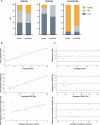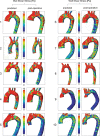Model-Based Therapy Planning Allows Prediction of Haemodynamic Outcome after Aortic Valve Replacement
- PMID: 28851875
- PMCID: PMC5575088
- DOI: 10.1038/s41598-017-03693-x
Model-Based Therapy Planning Allows Prediction of Haemodynamic Outcome after Aortic Valve Replacement
Erratum in
-
Publisher Correction: Model-Based Therapy Planning Allows Prediction of Haemodynamic Outcome after Aortic Valve Replacement.Sci Rep. 2019 Feb 26;9(1):3327. doi: 10.1038/s41598-018-36022-x. Sci Rep. 2019. PMID: 30804387 Free PMC article.
Abstract
Optimizing treatment planning is essential for advances in patient care and outcomes. Precisely tailored therapy for each patient remains a yearned-for goal. Cardiovascular modelling has the potential to simulate and predict the functional response before the actual intervention is performed. The objective of this study was to proof the validity of model-based prediction of haemodynamic outcome after aortic valve replacement. In a prospective study design virtual (model-based) treatment of the valve and the surrounding vasculature were performed alongside the actual surgical procedure (control group). The resulting predictions of anatomic and haemodynamic outcome based on information from magnetic resonance imaging before the procedure were compared to post-operative imaging assessment of the surgical control group in ten patients. Predicted vs. post-operative peak velocities across the valve were comparable (2.97 ± 1.12 vs. 2.68 ± 0.67 m/s; p = 0.362). In wall shear stress (17.3 ± 12.3 Pa vs. 16.7 ± 16.84 Pa; p = 0.803) and secondary flow degree (0.44 ± 0.32 vs. 0.49 ± 0.23; p = 0.277) significant linear correlations (p < 0.001) were found between predicted and post-operative outcomes. Between groups blood flow patterns showed good agreement (helicity p = 0.852, vorticity p = 0.185, eccentricity p = 0.333). Model-based therapy planning is able to accurately predict post-operative haemodynamics after aortic valve replacement. These validated virtual treatment procedures open up promising opportunities for individually targeted interventions.
Conflict of interest statement
The authors declare that they have no competing interests.
Figures






Similar articles
-
Hemodynamic Evaluation of a Biological and Mechanical Aortic Valve Prosthesis Using Patient-Specific MRI-Based CFD.Artif Organs. 2018 Jan;42(1):49-57. doi: 10.1111/aor.12955. Epub 2017 Aug 29. Artif Organs. 2018. PMID: 28853220
-
Reduction of aberrant aortic haemodynamics following aortic root replacement with a mechanical valved conduit.Interact Cardiovasc Thorac Surg. 2016 Sep;23(3):416-23. doi: 10.1093/icvts/ivw173. Epub 2016 May 30. Interact Cardiovasc Thorac Surg. 2016. PMID: 27245620 Free PMC article.
-
Perioperative evaluation of regional aortic wall shear stress patterns in patients undergoing aortic valve and/or proximal thoracic aortic replacement.J Thorac Cardiovasc Surg. 2018 Jun;155(6):2277-2286.e2. doi: 10.1016/j.jtcvs.2017.11.007. Epub 2017 Nov 16. J Thorac Cardiovasc Surg. 2018. PMID: 29248286 Free PMC article.
-
[The best of valvular heart disease in 2006].Arch Mal Coeur Vaiss. 2007 Jan;100 Spec No 1:19-28. Arch Mal Coeur Vaiss. 2007. PMID: 17405561 Review. French.
-
Transcatheter Aortic Valve Replacement: Imaging Techniques for Aortic Root Sizing.J Thorac Imaging. 2015 Nov;30(6):349-58. doi: 10.1097/RTI.0000000000000167. J Thorac Imaging. 2015. PMID: 26164166 Review.
Cited by
-
Discrete Subaortic Stenosis: Perspective Roadmap to a Complex Disease.Front Cardiovasc Med. 2018 Sep 13;5:122. doi: 10.3389/fcvm.2018.00122. eCollection 2018. Front Cardiovasc Med. 2018. PMID: 30320123 Free PMC article.
-
Algorithmic Generation of Parameterized Geometric Models of the Aortic Valve and Left Ventricle.Sensors (Basel). 2024 Dec 24;25(1):11. doi: 10.3390/s25010011. Sensors (Basel). 2024. PMID: 39796802 Free PMC article.
-
Transcatheter aortic valve implantation in a 13-year-old child with end-stage heart failure: a case report.Eur Heart J Case Rep. 2021 Feb 16;5(2):ytab034. doi: 10.1093/ehjcr/ytab034. eCollection 2021 Feb. Eur Heart J Case Rep. 2021. PMID: 33738418 Free PMC article.
-
Virtual Therapy Planning of Aortic Valve Replacement for Preventing Patient-Prosthesis Mismatch.Bioengineering (Basel). 2025 Mar 21;12(4):328. doi: 10.3390/bioengineering12040328. Bioengineering (Basel). 2025. PMID: 40281688 Free PMC article.
-
Computational Fluid Dynamic Assessment of Patients with Congenital Heart Disease from 3D Rotational Angiography.Pediatr Cardiol. 2025 Feb;46(2):458-466. doi: 10.1007/s00246-024-03443-7. Epub 2024 Mar 15. Pediatr Cardiol. 2025. PMID: 38489092
References
Publication types
LinkOut - more resources
Full Text Sources
Other Literature Sources

